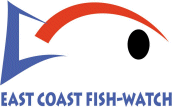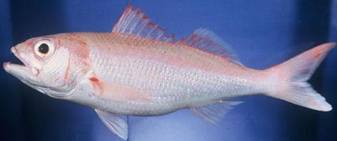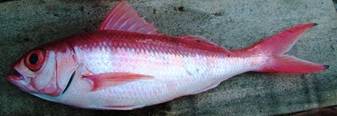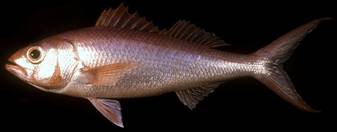

Conducted by

Sponsored by
East Coast
Fish-Watch Project
JANUARY - MAY REPORT 2007
Page 1 - Page 2 - Page 3 - Page 4
Range Extensions contd.
 |
A 40 cm ruby snapper Etelis carbunculus from the Comoros photographed by Phil Heemstra showing the deeply notched dorsal fin of Etelis species. |
 |
The 44 cm SL ruby snapper Etelis carbunculus photographed by Lucy Scott at Sodwana Bay. |
Lucy Scott also collected a ruby snapper, Etelis carbunculus at Sodwana Bay, another new distribution record for South Africa. Species of Etelis have no scales on the bases of their dorsal and anal fins and the dorsal fin is deeply notched between the spinous and soft portions of the fin. The ruby snapper Etelis carbunculus has a shorter tail fin than other Etelis species (lobes about 25—30% of standard length [SL] of specimens bigger than 120 mm SL). Lucy’s fish has dark tips to the tail fin-lobes which appears unusual. It has 17—22 gill rakers (including rudimentary gill rakers). Ruby snappers attain at least 80 cm and are common to 50 cm. They inhabit rocky bottoms at depths between 90—300 m and feed on fishes, some planktonic organisms and larger invertebrates like squid, shrimps and crabs. This Indo-central Pacific species is not known from the Red Sea and was previously known from the Seychelles, Comoros, Mauritius and Kenya in the western Indian Ocean. |
|
 |
The flame snapper Etelis coruscans which is known south to East London has a total of 23—28 gill rakers. Its upper tail fin lobe can be short to very long (33—75% of SL in specimens longer than 13 cm SL) and is longer than the lower lobe in some individuals. The 52 cm flame snapper (left) from Mauritius was taken by Jack Randall. |
The head of the 42 cm sabre squirrelfish Sargocentron spiniferum speared near Swartvlei. The large spine on the preopercle and the pointed head profile are characteristic of Sargocentron species. Photographs by Eric Roux.
|
Our largest squirrelfish (it attains 45 cm) is the distinctive sabre squirrelfish, Sargocentron spiniferum, which gets its name from the Latin for ‘bearing spines’. It has a large backwards projecting (retrorse) spine on the preopercle which is usually longer than the eye diameter. It is venomous and wounds caused by it are reported to be painful. This Indo-central Pacific coral reef species is generally found in caves and on rocky bottom and tends to emerge at night to feed on crabs and other crustaceans. It is usually solitary but has been seen in small groups in the Maldives. It comes as a great surprise to see the photograph (above) of a sabre squirrelfish speared close to shore off Swartvlei (between Knysna and Wilderness) on a rocky ledge over sandy bottom at a depth of about 5 m by Eric Roux. This is a range extension for a species previously known to KZN. |

